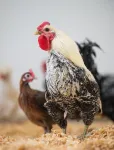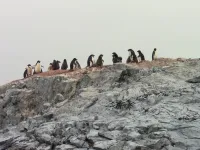(Press-News.org) New research suggests conservation efforts could more effectively identify and protect bird species at greatest risk from climate change by better understanding the range of specific conditions they need to thrive.
The study, led by the University of East Anglia (UEA), examined the relationship between the extent of the climatic conditions that species tolerate and in which populations can survive - known as climatic niche breadth - and their likelihood of declining in response to climate change.
For species inhabiting a similar area of geographic space, those able to tolerate a wider range of climate conditions are less likely to experience population declines, and are more likely to be increasing, compared to those with narrower climatic preferences.
The authors say their findings, published in the Journal of Biogeography, provide valuable insights into how climatic niche breadth can act as an important factor in predicting bird species vulnerability to climate change.
They suggest incorporating species' climatic niches into climate change risk assessments to better inform conservation strategies, arguing that variation in climatic conditions within a species range can provide greater nuance in understanding their resilience to factors that affect their population.
“Deciding which species are more at risk isn’t straight forward, and species may be declining for a range of reasons,” said lead author Karolina Zalewska, a postgraduate researcher in UEA’s School of Environmental Sciences.
“Rare species and those that have smaller distributions are more likely to be vulnerable to climate change. This study has shown that birds that are more widespread, such as the house sparrow and the common starling, can also face threats to their populations.
"Species, whether rare or widespread, with narrower climatic niches may be more susceptible to the rapid changes brought on by climate change compared to those with broader niches, and this may be one of the underlying reasons behind the population declines observed.
"Our results emphasise the importance of understanding and incorporating the level of exposure to climatic variability when assessing vulnerability to climate change and long-term population declines."
Human-induced climate change has increasingly been identified as a major threat to global biodiversity. However, the extent of this threat is likely to be uneven across species, due to differences in life histories or exposure to environmental change, with some climatic conditions, such as variables of temperature and rainfall, being more widespread than others across geographic area.
While species with broad geographic distributions would be expected to experience a wider range of climatic conditions and so be more resilient to environmental change, recent population declines of many widespread species suggest other factors may be involved, with the breadth of climatic conditions a species experiences being a possible indicator of their resilience to climate change.
Co-author Prof Aldina Franco, also from the School of Environmental Sciences, said: “Faced with the challenges of the global biodiversity crisis and climate change, the rapid assessment of species vulnerability to environmental change has become of paramount importance to address priorities for conservation. As climate change accelerates, our study highlights the need to prioritize species that are most at risk due to their more restricted environmental requirements.”
The researchers drew on data for the population trends of 159 European breeding bird species across 29 European countries from the Pan-European Common Bird Monitoring Scheme. These 40-year population trends were related to the climate conditions species experience and their distribution area.
They used 30-years of climate data for the species breeding ranges to construct representations of their climatic niches and produced a new index of climatic niche breadth that accounts for species distribution area.
This analysis, along with additional factors such as the species' diet, primary habitat type, migratory status, and average body mass, was then used to explore how these variables influence the long-term population trends.
“These findings can help us understand the threats associated with climate change and allow for rapid assessment of the importance of climatic factors on population trends, providing an invaluable tool for targeting species conservation,” added Miss Zalewska. “In particular, we show that the climatic niche breadth to range area index can help predict which species may be more vulnerable to population declines.”
Within the species included in this study, 58 had a decreasing population trend, populations of 68 species were stable and 33 were increasing.
As in previous studies the team found that species associated with farmland habitats, both in the UK and wider European area, such as the corn bunting or skylark, were more likely to be declining while those able to tolerate human-modified environments, including blackbirds and blue tits, were more likely to experience increasing population trends.
The work was supported by funding from the UK’s Natural Environment Research Council and the ARIES Doctoral Training Partnership.
‘European breeding bird declines associated with narrower climatic niches’, Karolina Zalewska et al is published in the Journal of Biogeography on April 10.
END
European bird declines linked to range of climatic conditions experienced
2025-04-09
ELSE PRESS RELEASES FROM THIS DATE:
'Hidden galaxies' could be smoking gun in universe riddle
2025-04-09
Astronomers have peered back in time to find what looks like a population of 'hidden' galaxies that could hold the key to unlocking some of the universe's secrets.
If their existence is confirmed it would "effectively break current models of galaxy numbers and evolution".
The possible galaxies may also provide the missing piece of the puzzle for the energy generation in the universe in infrared light.
That's because their combined light would be enough to top-up the energy budget of the universe to the maximum we observe, effectively ...
Love songs in the sand: researchers listen in to Fiddler crab courtship
2025-04-09
UNDER EMBARGO UNTIL 00:01 BST THURSDAY 10 APRIL / 19:01 ET WEDNESDAY 9 APRIL 2025
For the first time, a study led by University of Oxford researchers has ‘listened in’ to the fascinating courtship displays of Fiddler crabs using geophones. The findings, published today in the Journal of Experimental Biology, provide new insights into how the animals communicate effectively on the noisy seashore.
For male fiddler crabs, vibrational signals are a crucial part of their courtship routines – produced by drumming the ground using their oversized claw, ...
Study suggests lean muscle mass loss can be minimized during weight loss therapy using newer incretin obesity drugs
2025-04-09
New research to be presented at this year’s European Congress on Obesity (ECO 2025, Malaga, Spain, 11-14 May) shows that patients using GLP-1 or combined GLP-1 / GIP receptor agonist therapy for weight loss experienced minimal lean muscle mass loss as they lost weight across 6 months of treatment. The study is by Dr Dinabel Peralta-Reich, Donald and Barbara Zucker School of Medicine at Hofstra/Northwell; Lenox Hill Hospital, Northwell Health, New York City, NY, USA, and Dr Alexandra Filingeri, New York Weight Wellness Medicine, New York City, NY, USA, and colleagues.
GLP-1 (glucagon-like peptide-1) receptor agonists, ...
Aussie tech helps make bio-oils for greener industrial applications
2025-04-09
Australian technology developed at RMIT University could enable more sustainable and cheaper production of bio-oils to replace petroleum-based products in electronic, construction and automotive applications.
The technology, known as PYROCOTM, uses high temperatures without oxygen to convert treated sewage (biosolids) into a carbon-rich product called biochar, which can act as a catalyst to produce phenol-rich bio-oil.
PYROCOTM has been developed by RMIT in collaboration with South East Water, Intelligent Water Networks and other water authorities over several years and is now being applied to several exciting circular economy applications.
The RMIT team's latest research in collaboration ...
Map of genetic regulation in chickens could help fight against bird flu
2025-04-09
An international team of researchers led by Professor Huaijun Zhou from the UC Davis Department of Animal Science has created the first-ever detailed map of how genes are regulated in chickens — a breakthrough that could help scientists breed birds that are more resistant to diseases like avian influenza.
The study, published April 8 in Nature Genetics, brings together a massive amount of genetic and epigenetic data of more than 100 chicken breeds from around the world. The team, which ...
Scientists map unprecedented detail of connections and visual perception in the mouse brain
2025-04-09
What: In a massive scientific effort funded by the National Institutes of Health (NIH), hundreds of researchers have helped to map the connections between hundreds of thousands of neurons in the mouse brain and then overlayed their firing patterns in response to visual stimuli. This breakthrough is a critical piece of foundational science to build toward understanding how our brains process visual information to reconstruct the images we see every day.
Information processing in the human brain occurs ...
Mapping mercury contamination in penguins of the Southern Ocean
2025-04-09
In 1962, when environmentalist and author Rachel Carson penned Silent Spring, alerting the world to the dangers of the pesticide DDT, it was the reproductive threat to birds – the bald eagle in particular – that spurred people to action.
Six decades later, Rutgers University–New Brunswick researchers are taking the measure of another global environmental pollutant by drawing parallels to the crisis Carson identified. This time, the pollutant is mercury, and the sentinels are penguins living in the farthest reaches of the Antarctic Peninsula.
“With mercury, there’s an analogy to DDT,” said John Reinfelder, a professor in the Department of Environmental Sciences ...
Engineer aims to make giant leap for welding materials on the moon
2025-04-09
Before humans can colonize the moon or Mars, scientists and engineers must first develop techniques for building permanent structures and pressurized habitats in harsh, thin-atmosphere and low-gravity environments.
Dr. Wei Li, an assistant professor of mechanical engineering in the Erik Jonsson School of Engineering and Computer Science at The University of Texas at Dallas, is developing a virtual lunar welding platform to troubleshoot assembling large structures in such conditions.
“As we try to return to the ...
Tracking firearm violence and impact on dental health
2025-04-09
Higher firearm violence in neighborhoods is linked to lower rates of people going to the dentist and higher rates of total tooth loss, known as edentulism, according to Rutgers researchers.
Their study, published in the American Journal of Preventive Medicine, used data from the Centers for Disease Control and Prevention for dental care utilization and complete loss of teeth and data from the American Violence Project for firearm violence incidents. The researchers examined 20,332 census tracts within the 100 largest cities in the United States from 2014 to ...
3D streaming gets leaner by seeing only what matters
2025-04-09
A new approach to streaming technology may significantly improve how users experience virtual reality and augmented reality environments, according to a study from NYU Tandon School of Engineering.
The research — presented in a paper at the 16th ACM Multimedia Systems Conference on April 1, 2025 — describes a method for directly predicting visible content in immersive 3D environments, potentially reducing bandwidth requirements by up to 7-fold while maintaining visual quality.
The technology is being applied in an ongoing NYU Tandon National Science Foundation-funded project to bring point cloud video to dance education, making ...






